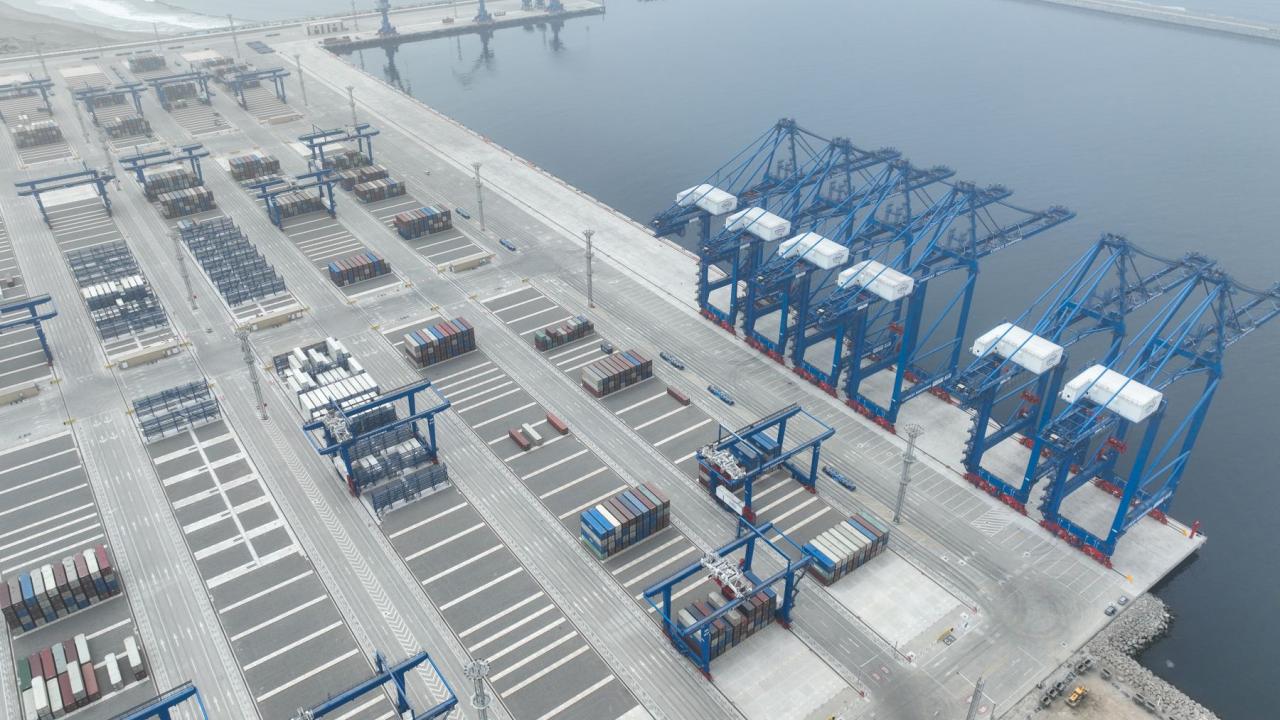
According to the 2025-2028 Macroeconomic Projections Update Report prepared by the Peruvian government, between November 2024 and February 2025, exports shipped through the port of Chancay totaled US$170 million.
Since November 14, 2024, when the first phase of the Chancay port (located 80 kilometers from Metropolitan Lima) was inaugurated, the "commissioning" or "white march" phase of the port terminal began with the arrival and departure of vessels, registering a great dynamism in commercial activity, especially exports.
According to the 2025-2028 Macroeconomic Projections Update Report, prepared by the Ministry of Economy and Finance (MEF), between November 2024 and February 2025, exports shipped through the port of Chancay totaled US$170 million.
Among the products shipped from the Chancay port terminal are palm oil (US$40.7 million), avocados (US$33.6 million), blueberries (US$33.1 million), grapes (US$10.3 million), copper (US$4.9 million), and garlic (US$4.1 million), among others.
The main destination markets for Peruvian exports from the port of Chancay are the Netherlands (19% of shipments), China (18%), the United States (15%), Mexico (15%), Colombia (8%) and Ecuador (5%), according to an article published in the newspaper El Peruano .
Given the strong performance of commercial activity in the "commissioning" phase, which ends this month and is expected to begin operations on June 1, the MEF's Macroeconomic Projections Update Report 2025-2028 predicts that "the second phase of the Chancay port will begin in 2027 with an investment exceeding US$1.3 billion."
"It would complement the first stage of the port infrastructure and seek to meet the expected increased demand for port services associated with the consolidation of the port hub ," explains the MEF document.
Port experts agree that the start of the second phase will depend on the container volumes achieved in 2025 and next year, although it could begin with the pre-investment phase (socio-environmental permits and detailed engineering).
PORT LANDMARK
The new Chancay multipurpose port terminal, located in the district of the same name (Huaral province), marked a milestone in port infrastructure for establishing the new Silk Road, which will unite Latin America and Asia, giving meaning to the phrase "From Chancay to Shanghai."
The Chancay port is operated by the Chinese company Cosco Shipping Ports, part of the Ocean Alliance business group, which transports 39% of global container cargo and has a portfolio of terminals covering the main port regions of mainland China, Southeast Asia, the Middle East, Europe, South America, and the Mediterranean.
Therefore, the arrival of the giant Chinese operator opens up a wide range of commercial and investment opportunities in Peru, considering that the port of Chancay contemplates a total investment exceeding US$3.4 billion, of which US$1.315 billion was executed in the first phase.
The construction of the first phase of the Chancay port generated 1,300 direct jobs and around 8,000 indirect jobs due to the economic growth already evident in the area.
The Chinese company Cosco Shipping Ports highlights the Port of Chancay as a key maritime point for trade between South America and Asia, primarily China (the port of Shanghai), because it will become a regional hub that will redistribute cargo from Peru, Brazil, Chile, Ecuador, Colombia, and other Latin American countries.
"Today, it takes between 35 and 40 days to get from South America to Asia (China, Korea, or Japan), but with the port of Chancay, ships will be able to arrive in 23 days, as the connection will be direct, especially considering that Chile does not have a direct route to Asia," Cosco Shipping Ports emphasized.
The Port of Chancay can accommodate large vessels to meet growing port demand, reduce costs in the domestic and international markets, and positively impact the Peruvian economy.
FIRST LANDINGS
The first cargo received at the port of Chancay was in the second week of November 2024, with a shipping vessel carrying electric vehicles from Shanghai, China, and other products.
The Xin Shanghai, a container ship operated by China Cosco Shipping Corporation Limited, then departed Chancay and arrived at Yangshan Port in Shanghai on December 18 after a 23-day voyage, becoming the first vessel to arrive in China since the official opening of Chancay Port.
The voyage also marked the opening of a two-way operational maritime link between Shanghai and Chancay, a flagship project of cooperation between China and Peru within the framework of the Belt and Road Initiative. The voyage's cargo included a variety of Peruvian products, such as blueberries, avocados, and mineral products.
However, the port of Chancay will not only boost Peruvian exports to China, but also to Australia, Hong Kong, and other markets.
FOREIGN TRADE
The MEF's 2025-2028 Macroeconomic Projections Update Report highlights that the port system constitutes a strategic infrastructure for the growth of the Peruvian economy.
“In 2024, 128 million tons were moved (8.4% more than in 2023), far exceeding the pre-pandemic period (2019: 109 million tons). With this growing trend of increased port activity, Peru has positioned itself in fifth place in Latin America in terms of integration into global maritime trade, after Panama, Mexico, Colombia, and Brazil,” states the recently published MEF document.
"The entry into operation of the Port of Chancay will streamline the increased port cargo, consolidating Peru as a logistics hub in the South Pacific and reducing shipping times to Asia," he added.
NATIONAL PORT SYSTEM
Peru's National Port System comprises 59 public and private ports currently operating along the Peruvian coastline and rivers.
The National Port Authority (APN) indicated that, of the 59 port terminals, 42 are for private use, that is, ports owned by companies, such as, for example, the mining company Antamina, which has a port in Huarmey (Áncash) for the export of metals.
He noted that the other 17 ports are for public use: eight terminals are under concession, seven are managed by the National Port Company (ENAPU), one is managed by the Peruvian Logistics Company of the East in Pucallpa (Ucayali), and the last is Chancay (Lima Province).
The APN is the decentralized public body responsible for managing and developing the National Port System (maritime, river, and lake), and also implements a state policy aimed at working with the private sector.
It also develops the National Port Development Plan, promotes private participation in publicly owned ports, establishes sectoral procedures, and issues technical standards for port activities and services in Peru.
"We need a partner, and that's the private sector, because the port can't function without investment and operations. From the State, we foster a trustworthy environment for this to truly happen, all with the goal of strengthening ourselves as a country through a functioning port system that serves as a gateway to the world," stated Juan Carlos Paz, president of the APN board of directors.
"Our goal is to strengthen the competitiveness of our national ports to support the growth of foreign trade and the challenges of globalization and sustainability," he added.
DATA
- The Chancay multipurpose port terminal has three components: the first is the port operational area, which includes the piers, maritime access channels, maintenance areas and workshops, as well as storage spaces for containers and bulk and rolling cargo.
- The second is the entrance complex, which includes the vehicle outer harbor, entrance gates, customs inspection area, administrative offices, and logistics and support services area.
- The third component is the 1.8-kilometer-long tunnel, part of a road corridor for cargo traffic related to port operations. This underground viaduct has three vehicle lanes, two conveyor belts for solid bulk, and pipelines for liquid bulk.










